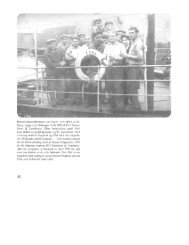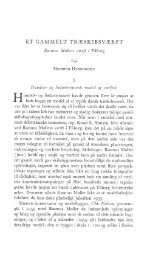Sømandens våde grav, s. 103-167 - Handels- og Søfartsmuseet
Sømandens våde grav, s. 103-167 - Handels- og Søfartsmuseet
Sømandens våde grav, s. 103-167 - Handels- og Søfartsmuseet
Create successful ePaper yourself
Turn your PDF publications into a flip-book with our unique Google optimized e-Paper software.
telling how they were mistreated by the people living near the beach, who sometimes<br />
chopped off their fingers to take their rings, stole their boots, scarves,<br />
money etc, and threw them down on to the beach instead of giving them a Christian<br />
burial. Local people were also afraid that the dead might be Catholics, or<br />
heathens such as Turks or Russians. Thus it was quite common for sailors to get<br />
tattooed with a crucifix in order to show that they were Christians. There are a<br />
large number of »dead men's hills« along the west coast of Jutland, where it was<br />
considered dangerous to roam at night in case the dead returned and claimed<br />
their stolen limbs and valuables back. They were said to jump up on the backs<br />
ofthe guilty ones and frighten them into handing over the stolen objects. Their<br />
greatest wish, however, was to be buried in the consecrated ground ofthe churchyard,<br />
where they could lie in peace to rest until the Day of Judgement.<br />
Upon doser examination, however, it turns out that these legends for the<br />
most part are belied by the legislation ofthe time. Most beach washers were in<br />
actual faet buried in the churchyard. Up through the ages the laws have<br />
stipulated that the dead must have a decent burial. From Catholic Denmark and<br />
other countries we hear how some people, out of love for their fellow man,<br />
formed brotherhoods to patrol the beaches and bring the dead to rest in a<br />
Christian manner.<br />
The very best thing for a sailor was of course to come home after his perilous<br />
voyages, put something aside for a peaceful old age, and eventually be buried<br />
with due ceremony in his own churchyard. Then the bereaved family had a<br />
place to assemble and mourn him. Afterwards a beautiful <strong>grav</strong>estone with<br />
maritime symbols was placed over the <strong>grav</strong>e and everything was as it should be.<br />
Memorial services were often held for the ones who never returned, services<br />
which were believed to have a long-distance beneficial effect on their soul just<br />
like requiems and prayers in the Catholic Church. Empty memorial <strong>grav</strong>es<br />
stood in many piaces waiting for the dead.<br />
In our day it is becoming more and more the fashion to be cremated and then<br />
have the ashes strewn into the sea. This romantic idea would have appalled the<br />
sailors of old, for whom soul and body were quite closely linked.<br />
Burial at sea is now an extremely uncommon event, indeed it is even forbidden<br />
entirely on Italian ships for example. But even if much superstition<br />
has vanished death is still life's great problem.<br />
<strong>167</strong>

















